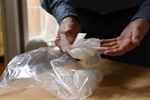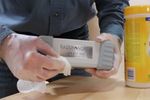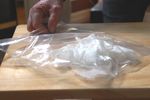Radon Testing Hygiene Protocol In Times of COVID-19 (Coronavirus) and Similar Contagions - IDPH
←
→
Page content transcription
If your browser does not render page correctly, please read the page content below
Radon Testing Hygiene Protocol
In Times of COVID-19 (Coronavirus) and Similar Contagions
“This Protocol is Guidance Only – Test Professionals / Inspectors must respect & follow local directives pertaining to
existing conditions in the jurisdiction of intended services!”
Prepared by: Michael LaFontaine, P.Phys., RSO
Backgrounder
Effective 11 March 2020, but a reality for several weeks, the World
Health Organization (WHO) declared COVID-19 (Coronavirus) a
pandemic, i.e., a worldwide epidemic. According to Merriam-
Webster, “a coronavirus is any of a family (Coronaviridae) of single-
stranded RNA viruses that have a lipid envelope studded with club-
shaped projections, infect birds and many mammals including
humans, and include the causative agents of MERS, SARS and
COVID-19.”
Figure 1 – COVID-19
Most countries have been impacted by this virus to some degree – it (Source: www.nieuwsblad.be)
overran Asia, marched across Europe, and is now advancing through
the Americas. Time will only tell whether the virus is contained and
controlled over the course of the coming weeks and months.
What the Health Experts are Saying
The following is taken directly from the WHO website
https://www.who.int/health-topics/coronavirus:
Stay aware of the latest information on the COVID-19 outbreak,
available on the WHO website and through your national and
local public health authority. Many countries around the world
have seen cases of COVID-19 and several have seen outbreaks.
Authorities in China and some other countries have succeeded in
slowing or stopping their outbreaks. However, the situation is
unpredictable so check regularly for the latest news.
Figure 2 – COVID-19 Doctors & Patient
You can reduce your chances of being infected or spreading (Source: World Health Organization names the new
COVID-19 by taking some simple precautions that are coronavirus: Covid-19)
recommended for all radon measurement and home inspection
professionals (italics are the author’s):
• Regularly and thoroughly clean your hands with a > 60% alcohol-based hand rub / sanitizer or wash
them with soap and warm water for at least 30 seconds. Why? Washing your hands with soap and warm
water for at least 30 seconds or using alcohol-based hand rub kills viruses that may be on your hands
(they destroy the virus’s lipid envelope).
• Maintain at least 2 metres (6 feet) distance between yourself and anyone who is coughing or sneezing.
Why? When someone coughs or sneezes they spray small liquid droplets from their nose or mouth
which may contain virus. If you are too close, you can breathe in the droplets, including the COVID-19
virus if the person coughing has the disease.
Page 1|6• Avoid touching your face, i.e., eyes, nose, mouth and ears. Why? Hands touch many surfaces and can
pick up viruses (viruses can survive in excess of 2 days on surfaces, lifetime varies with temperature,
light and humidity). Once contaminated, hands can transfer the virus to your eyes, nose, mouth or ears.
From there, the virus can enter your body and can make you sick.
• Make sure you, and the people around you, follow good respiratory hygiene. This means covering your
mouth and nose with your bent elbow or tissue when you cough or sneeze. Then dispose of the used
tissue immediately into a covered disposal / waste container. Wash your hands frequently to minimize
contamination on surfaces. Why? Droplets spread virus (by as much as 2 metres or in excess of 6 feet).
By following good respiratory hygiene you protect the people around you from viruses such as cold, flu
and COVID-19.
• Stay home if you feel unwell. If you have a fever, cough and difficulty breathing, seek medical attention
and call in advance. Follow the directions of your local health authority. Why? National and local
authorities will have the most up to date information on the situation in your area. Calling in advance
will allow your health care provider to quickly direct you to the right health facility. This will also
protect you and help prevent spread of viruses and other infections.
• Keep up to date on the latest COVID-19 hotspots (cities or local areas where COVID-19 is spreading
widely). If possible, avoid traveling to places – especially if you are an older person or have diabetes,
heart or lung disease. Why? You have a higher chance of catching COVID-19 in one of these areas.
In addition to the above, use a disinfectant wipe (as listed below) to wipe down your cellphone every time you
enter or leave a new indoor environment!
Essentials
The following should become part of your standard radon test / home inspection kit:
• Vinyl, latex-free, medical examination gloves (lightly powdered preferable) sized to be snug fit on user.
Should comply with ASTM 5250 “Standard Specification for Poly(vinyl chloride) Gloves for Medical
Application” and/or ISO 13485:2016 “Medical devices — Quality management systems —
Requirements for regulatory purposes.”
• Vinyl zip-lock bags – sized to fit the test equipment being used.
• Abrasion & fluid resistant, anti-slip, polypropylene footwear covers, i.e., “booties.”
• Disinfectant wipes (Clorox®, Lysol® or similar). *
• Disinfectant spray (Lysol® or similar). *
• Multi-surface cleaner/disinfectant (Clorox®, Lysol®, Pine-Sol® or similar). *
* In accordance with the EPA Viral Emerging Pathogen Policy and
Health Canada’s Viral Emerging Pathogen Policy.
Disclaimer: The author has no commercial or financial interest in any of the mentioned products.
Visitation Basics
The following should be basic practice for all radon testers and home inspectors:
1. HEALTH & SAFETY FIRST – Protect yourself and protect your clients; if in doubt, don’t deploy or
retrieve test devices. Limit sites visited to 1 per day.
Page 2|62. If you’re coughing, sneezing, or feeling sick and feverish DON’T go to your client’s home or building
(Note: If you have “smoker’s cough” or allergies, this may still be the best course of action.). Arrange
for a healthy co-worker to take your place or reschedule. Meanwhile, call your local telehealth or health
authorities, family physician, etc., and if appropriate, arrange for a COVID-19 screening test.
3. Contact your client prior to your appointment and confirm whether any occupants of the location to be
visited are sick, coughing or sneezing, and if so, have they tested positive for COVID-19. If the answer
is yes, delay your visit until such time as occupants are healthy and the building has been disinfected.
4. DON’T HYPE HYSTERIA! Don’t panic your client by turning up in full hazmat gear – booties and
gloves will suffice. **
5. Prior to entering building:
a. NO HANDSHAKE!
b. For Deployment: Put on gloves, then cover footwear with booties.
c. For Retrieval: Put on gloves, then cover footwear with booties. Bring in vinyl zip-lock bags as
per Essentials above to bag the devices being retrieved.
Device Deployment
Once you have your protective wear on as per 5b above, enter the premises and deploy devices as per your
standard operating procedures.
Device Retrieval
After you have donned your protective wear and have your additional supplies as per 5c above, enter the
premises and retrieve your devices as per your standard operating procedures with the following additional
steps:
1. Wipe the outer surfaces of the deployed devices with a disinfectant wipe as listed in Essentials above
(Notes: 1) Electret Ion Chambers should be placed in the “closed” configuration. 2) DO NOT perform
electret voltage readings NOR analyse the results from other monitoring devices at the client’s site.).
See Figures 3 & 4.
Figure 3 – Wiping CRM Figure 4 – Wiping ATD
(Source: Radon North) (Source: Radon North)
Page 3|62. Seal “clean” devices into zip-lock bags after
thorough wiping with disinfectant wipes. See Figure
5.
Affix a label to each bag, indicating:
a) Contents have been wiped with a disinfectant
in compliance with the EPA Viral Emerging
Pathogen Policy and / or Health Canada’s
Figure 5 – Devices Packed in Zip-Lock Bags
Viral Emerging Pathogen Policy, or your (Source: Radon North)
jurisdiction’s equivalent.
b) Date (dd/mm/yyyy)
c) Your signature.
3. Place used disinfectant wipe(s) into spare zip-lock bag and remove gloves as follows:
Figure 6 – Left Glove Removal Start Figure 7 – Right Glove Removal Start
(Source: Radon North) (Source: Radon North)
Figure 8 – Right Glove Removal Finish Figure 9 – Left Glove Removal Finish
(Source: Radon North) (Source: Radon North)
Figure 10 – Gloves & Wipe(s) Bagged
(Source: Radon North) Page 4|64. Place used gloves into zip-lock bag with used disinfectant wipes.
5. Exit building. Remove booties by pulling down on the elastic cuff above the heel (using thumb and
forefinger). Place both in a spare zip-lock bag.
6. Spray all zip-lock bags with disinfectant spray and place in tote box. Place in vehicle.
7. Spray clothing and hands with disinfectant spray. DON’T TOUCH YOUR FACE until after you’ve
washed your hands as per page 1.
8. Return to office. Process all devices as per usual (Note: Devices being sent to a lab for analysis should
not be removed from their sealed zip-lock bags.).
9. Discard the zip-lock bags containing the used disinfectant wipes, gloves and booties into a covered
disposal bin/ waste container.
10. Clean tote with multi-surface cleaner/disinfectant. Wash your hands as per page 1, change out of your
work clothes (place used ones in a wash bag to be laundered separately), and shower thoroughly when
you get home.
** Addenda Regarding Face Masks **
(Why they’re not listed under “Essentials”)
According to medical doctors on the ground, the surgical masks (typically blue outside, white towards face)
being purchased by the general public, WILL NOT protect the wearer from COVID-19. These masks, which
feature a flexible metal strip for contouring the top of the mask to the nose, and elastic loops for securing the
mask to the wearer’s ears; are not hermetically sealed to the wearer’s face. i.e., they are ineffective protection
against small aerosolized respiratory droplets – one of the primary delivery vectors for COVID-19. These
masks are also ineffective for wearers with beards.
Masks should only be worn by those general public individuals who are exhibiting symptoms of COVID-19 or
test positive for COVID-19; and then, to prevent the infection of others.
Page 5|6ACKNOWLEDGEMENTS
The endorsements, reviews and comments provided by the individuals listed, are those of the individuals
and do not necessarily reflect the policies or views of their respective affiliations.
The author is grateful to all reviewers for their endorsements, insights and comments; in particular (in order of
feedback):
1. William J. Angell, Professor Emeritus, College of Design, University of Minnesota & Past-Director,
Midwest Universities Radon Consortium www.cce.umn.edu/radon; Chair, Prevention and Mitigation
Working Group, International Radon Project, World Health Organization
www.who.int/ionizing_radiation/env/radon/en/; Past President, American Association of Radon
Scientists and Technologist, www.aarst.org
2. Shawn Price, Director of Laboratory Operations - Spruce Environmental Technologies, Inc.; Past
President, American Association of Radon Scientists and Technologist, www.aarst.org
3. Nathaniel L. Burden, Jr., PA AARST Chapter President, radon scientist/consultant
4. Jim F. Herrold, CHP, Research Safety Specialist/Radiation Safety Officer - University of Wyoming,
Office of Research & Economic Development; US TAG Chair - ISO TC 85/SC 2 “Radiological
Protection”; ANSI/ASTM/HPS
5. Alan J. Whitehead, President & CEO - Radon Environmental/Radon Corp; President, Canadian
Association of Radon Scientists and Technologist, www.carst.ca
6. Leo Moorman, Ph.D., Radon Home Measurement and Mitigation, Inc., Fort Collins, CO
7. Gary Hodgden, ANSI/AARST/EPA Consortium Assist
8. Alexandra Stieff-Davis, Manager & Radon Specialist - Rad Elec, Inc.
9. Bill Field, Ph.D., MS, Deputy Director - Heartland Center for Occupational Health & Safety; Professor,
Department of Occupational and Environmental Health, Department of Epidemiology, College of Public
Health, University of Iowa
10. Lorin Stieff, Technical Specialist - Rad Elec, Inc.
And my toughest critic and major booster – my wife, Ildiko!
Page 6|6You can also read


























































